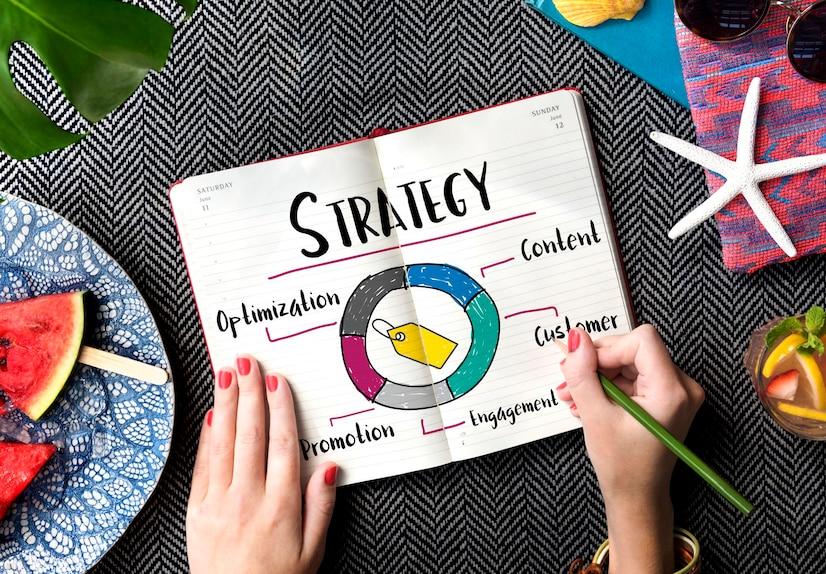Table Of Contents
- Digital Content Marketing Strategy: A General Overview
- Best Practices of Digital Content Marketing
- 1. Define Goals And Mission
- 2. Set Key Performance Indicators (KPIs)
- 3. Know Your Target Audience
- 4. Identify The Ideal Content Channels
- 5. Choose What Kind Of Content To Publish
- 6. Produce Content
- 7. Evaluate The Results
- Develop Your Digital Content Marketing Strategy Now
Top 7 Best Practices of Digital Content Marketing Strategy
Last Updated on: December 18th, 2024
Digital content marketing is the creation and dissemination of high-quality, helpful, and relevant content to establish a connection with your target audience. This includes blogs, newsletters, emails, podcasts, social media posts, videos, and white papers.
When done right, you can show people your expertise in a specific field. Also, with good content development, you can show that you value them not only as customers but also as partners. And when they consider you as a partner and source of relevant information, they’ll likely choose you over your competitors.
With that said, content marketing can only succeed with a well-established digital content strategy. Without a plan, everything will plunge into chaos, and the marketing campaign might just waste resources for nothing. So, before you start posting content, it’d be best to do some research and devise a plan.
Digital Content Marketing Strategy: A General Overview
By creating a digital content marketing strategy, you plan to develop and share content for your target audience. Here, your goal is to engage your audiences with your website, social media posts, and blogs. Your ultimate goal is to convert interested audiences into buying customers.
If you do not have a content marketing strategy to guide you, you cannot concentrate your efforts. Basically, you need to ensure that your content aligns better with your business goals. Hence, you will not need to waste your resources to create something without value.
Apart from that, with the help of a strong strategy, you can get support from stakeholders. Moreover, you can communicate your content marketing’s value and effort to the management.
Furthermore, having a strategy helps you streamline the content marketing process. Additionally, you can also make the distribution process better. Also, you can analyze and track your results. This will help you to determine where you need to improve.
Best Practices of Digital Content Marketing
If you don’t know where to start, this post got you covered. This article will guide you through the key steps to developing a content marketing strategy to help your business grow without taking too many valuable resources.
But remember, if you feel that the task is too much for you to handle, consider asking professional marketing consultants and advisors for help. Check out the Sortlist glossary of marketing firms and find out which one can help provide your needs.
The following are the steps you must follow if you want to ensure effective digital content marketing practices for your business:
1. Define Goals And Mission

When building a content strategy, the first thing to do is to establish a mission statement. This is a short sentence (or paragraph) that guides the content creation team in ensuring the consistency of the strategy throughout the process. It also points out the things that aren’t important in the process.
A good mission statement should outline the following elements:
- Your company’s target audience
- The type/s of content to be used
- The benefits people will receive
Here’s a simple formula you can use when creating a mission statement:
Our company provides [your target audience] with [the content to be used] to help them [your goal].
Here’s an example of applying the formula above:
‘Our company provides business executives with unparalleled expertise on digital transformation and certification to help them gain insights on growth and development.’
Aside from the company mission, it’s also important to determine what your business will receive in return. This is where your goals enter the picture. Below are some examples of business goals you may use:
- Lower marketing costs
- Generate more sales
- Increase revenue
- Boost social media engagement
- Generate better leads
- Gain authority
- Boost your site’s traffic
Once you’ve clearly defined your goals and mission, you’re now ready for the next phase.
2. Set Key Performance Indicators (KPIs)
Your goals must be specific and measurable to make it easy to fulfill them. And to do that, you need to establish the right KPIs for your strategy. These will tell you whether you’ve fulfilled your goals by evaluating multiple milestones throughout the process.
Usually, KPIs include numerical limits and trigger points, for example:
- Reach your target revenue every week, month, or year.
- Achieve a specific number of subscribers.
- Check if there’s an increase in traffic to your content.
- Achieve a higher number of signups to generate leads.
- Boost your ranking in search engines.
Aside from your goals, it’s also important to measure your expenses on different campaigns, such as the cost of sales and getting new leads. This can help ensure that you’re gaining and not losing money. aining and not losing money.
3. Know Your Target Audience
Knowing your target audience will help determine the right content to produce. For example, if you are advertising via live stream, or making an appearance at an event to promote your business, you might want to hire an executive speechwriter to create your content. Otherwise, you’ll never know whether your content is succeeding or not.
Below are the following actions to take to identify your target audience.
- Gather Demographics: Check your site visitors, followers, and subscribers and collect data, such as age, gender, income, and education. You can use all of these to create personalized content later on.
- Get Feedback: To learn more about your target audience, ask for their feedback regarding your products and services. This will help you understand their needs and priorities, as well as gather information on where to reach them.
- Create Buyer Personas: Buyer personas, or customer avatars, help describe your target audience so you can produce the right content that satisfies their needs. These include your customers’ problems, behaviors, motivations, and information sources.
When done right, you can produce the right content people will respond to, thus, increasing the chances of driving traffic to your site and making more sales.
4. Identify The Ideal Content Channels

After knowing your target audience, it’s time to determine the right content channel where they hang out, and where you already have a presence. It’d be better to focus and grow on one channel at a time than multiple channels at once.
Here are some content channels to choose from:
- Video streaming sites (e.g., YouTube)
- Websites and blog sites
- Social media platforms
- Audio streaming sites
- Communities (e.g., Reddit)
If you want to make sure, go to Google Analytics to find out where your target audience shares your content. With this, you can determine where to post your content to improve your visibility, engagement, and shares.
5. Choose What Kind Of Content To Publish
Once you’ve identified where to engage, it’s time to determine the type of content to produce. You may choose from the following:
- Blog posts (articles published onsite or as guest posts through link-building. Here, a guest post link building service for your target niche can be an ideal solution to outrank the competition)
- Email newsletters
- Social media content (e.g., Instagram Reels and Stories)
- Guides (e.g., A Complete Guide To Eating Sushi)
- How-to articles (e.g., How To Eat Sushi Properly)
- Listicles (e.g., 10 Ways To Eat Sushi)
- eBooks
- Case Studies
Ideally, you want your content to be as valuable as possible to build audience trust and establish authority over your competitors.
6. Produce Content
First, congratulations! You’ve completed all the necessary preparation before content creation. Now, you can produce the right content your target audience needs.
Here are some tips you can use when creating content:
- Do Some Research: Doing some research will help you find out what has already been published and how you can improve it to satisfy your audience.
- Keyword Research: This will help you identify the right words to include in your content. These words will help your content outrank your competitors in search engines.
- Create Content: When creating content, evaluate the personality you want to show your audience. Do you want to be casual, professional, or slightly casual and professional?
Once you’re done, it’s time to share your content and market it to boost its visibility and increase your site’s traffic.
However, if you think this is too much of a task, you can outsource it to expert content marketing services. These agencies will produce SEO-friendly and engaging content to bring your audience to your business. Also, they ensure that your target audiences become buying customers. Hence, look for top content marketing SEO services now.
7. Evaluate The Results

After producing and releasing your content, don’t forget to evaluate the results. Check how many shares, comments, and engagements it has produced for the past week or month to determine whether it’s successful.
If it’s not, determine what went wrong during the process. Was it the channel where you posted your content? Were your keywords not suitable for your content? Once you’ve identified what went wrong, address your mistakes by correcting and avoiding them in the future.
Develop Your Digital Content Marketing Strategy Now
Developing a digital content marketing strategy is no easy task. There’s plenty of information to gather and factors to consider. But when done right, you’ll provide value to your audience, establish authority over competitors, and encourage the audience to buy your offerings. Use this guide to create an effective and foolproof content marketing strategy.
Do you have more suggestions to add regarding which digital content marketing service to use? Please share your ideas and opinions in the comments section below.














